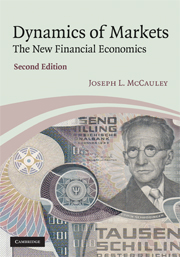Book contents
- Frontmatter
- Contents
- Preface to the second edition
- 1 Econophysics: why and what
- 2 Neo-classical economic theory
- 3 Probability and stochastic processes
- 4 Introduction to financial economics
- 5 Introduction to portfolio selection theory
- 6 Scaling, pair correlations, and conditional densities
- 7 Statistical ensembles: deducing dynamics from time series
- 8 Martingale option pricing
- 9 FX market globalization: evolution of the Dollar to worldwide reserve currency
- 10 Macroeconomics and econometrics: regression models vs empirically based modeling
- 11 Complexity
- References
- Index
9 - FX market globalization: evolution of the Dollar to worldwide reserve currency
Published online by Cambridge University Press: 02 December 2010
- Frontmatter
- Contents
- Preface to the second edition
- 1 Econophysics: why and what
- 2 Neo-classical economic theory
- 3 Probability and stochastic processes
- 4 Introduction to financial economics
- 5 Introduction to portfolio selection theory
- 6 Scaling, pair correlations, and conditional densities
- 7 Statistical ensembles: deducing dynamics from time series
- 8 Martingale option pricing
- 9 FX market globalization: evolution of the Dollar to worldwide reserve currency
- 10 Macroeconomics and econometrics: regression models vs empirically based modeling
- 11 Complexity
- References
- Index
Summary
Introduction
We return to the theme introduced in the first chapter, economists' expectations of stable equilibrium vs the reality of market instability under deregulation. We'll now illustrate the disparity by following the evolution of the Dollar and FX markets from the gold standard to September, 2008.
We begin by following Eichengreen's (1996) informative history of the evolution of western FX markets from the gold standard of the late nineteenth century through the Bretton Woods Agreement (post-WWII–1971) and later the floating currencies of the early market deregulation era 1971–1995. We add equations, models, and observations to broaden that discussion and explain mathematically how the FX markets work. We also add a discussion of the era 1995–2008 based on our understanding of finance markets gained in Chapter 7.
Although WWI-era finance data (or any pre-computerization-era data) would be too sparse to permit a meaningful empirical analysis (see Chapter 7), there is qualitative evidence for a change from stability to instability over the time interval of WWI. With the risk and instability of our present era (Chapters 7 and 8) in mind, we show how speculators could have made money systematically from an effectively regulated FX market like that of the gold standard era. The present era normal liquid FX markets are in contrast approximately impossible to beat, are “efficient,” and require options to hedge against currency risk. The ideas of Martingales and options/hedging became of great practical importance after 1971, but were of little use or interest in the gold standard era.
- Type
- Chapter
- Information
- Dynamics of MarketsThe New Financial Economics, pp. 188 - 213Publisher: Cambridge University PressPrint publication year: 2009



